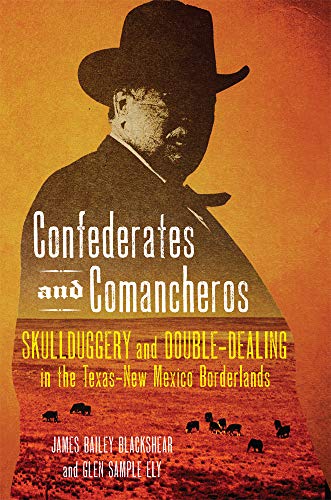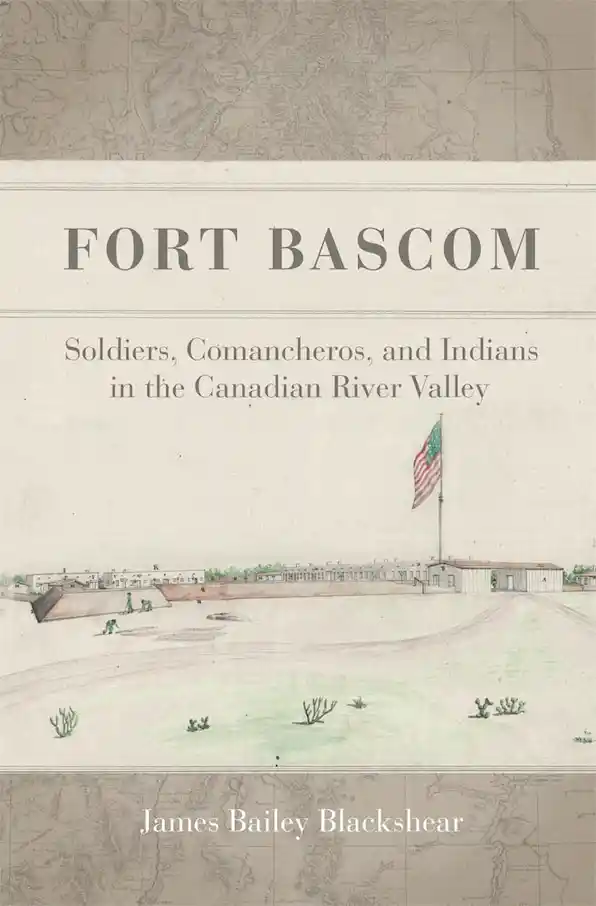Released: 9/29/2021| Publisher: The University of Oklahoma Press | Formats: Hardcover & Kindle (288 Pages)

A vast and desolate region, the Texas–New Mexico borderlands have long been an ideal setting for intrigue and illegal dealings—never more so than in the lawless early days of cattle trafficking and trade among the Plains tribes and Comancheros. This book takes us to the borderlands in the 1860s and 1870s for an in-depth look at Union-Confederate skullduggery amid the infamous Comanche-Comanchero trade in stolen Texas livestock.
In 1862, the Confederates abandoned New Mexico Territory and Texas west of the Pecos River, fully expecting to return someday. Meanwhile, administered by Union troops under martial law, the region became a hotbed of Rebel exiles and spies, who gathered intelligence, disrupted federal supply lines, and plotted to retake the Southwest. Using a treasure trove of previously unexplored documents, authors James Bailey Blackshear and Glen Sample Ely trace the complicated network of relationships that drew both Texas cattlemen and Comancheros into these borderlands, revealing the urban elite who were heavily involved in both the legal and illegal transactions that fueled the region’s economy.
Confederates and Comancheros deftly weaves a complex tale of Texan overreachand New Mexican resistance, explores cattle drives and cattle rustling, and details shady government contracts and bloody frontier justice. Peopled with Rebels and bluecoats, Comanches and Comancheros, Texas cattlemen and New Mexican merchants, opportunistic Indian agents and Anglo arms dealers, this book illustrates how central these contested borderlands were to the history of the American West.
- James Brooks, Author of Captives and Cousins: Slavery Kinship, and Community in the Southwest Borderlands
- Thomas Ty Smith, Author of The Old Army in the Big Bend: The Last Cavalry Frontier, 1911-1921
- Rick Hendricks, Co-author of Pueblo Sovereignty: Indian Land and Water In New Mexico and Texas
- Civil War Books and Authors

Westerners International
1st Place, Co-Founders Best Book Award

Will Rogers Medallion Award
1st Place, Will Rogers Gold Medallion Award
Released: 3/18/2016| Publisher: The University of Oklahoma Press | Formats: Hardcover, Kindle & E-Book (272 Pages)

Motorists traveling along State Highway 104 north of Tucumcari, New Mexico, may notice a sign indicating the location of Fort Bascom. The post itself is long gone, its adobe walls washed away. In 1863, the United States, fearing a second Confederate invasion of New Mexico Territory from Texas, built Fort Bascom. Until 1874, the troops stationed at this site on the Eroded Plains along the Canadian River defended Hispanic and Anglo-American settlements in eastern New Mexico and far western Texas against Comanches and other Southern Plains Indians.
In Fort Bascom, James Bailey Blackshear presents the definitive history of this critical outpost in the American Southwest, along with a detailed view of army life on the late-nineteenth-century western frontier. Located in the middle of what General William T. Sherman called “an awful country,” Fort Bascom’s hardships went beyond the army’s efforts to control the Comanches and Kiowas. Blackshear shows the difficulties of maintaining a post in a harsh environment where scarce water and forage, long supply lines, poorly constructed facilities, and monotonous duty tested soldiers’ endurance.
Fort Bascom also describes the social aspects of a frontier assignment and the impact of the Comanchero trade on military personnel and objectives, showing just how difficult it was for the army to subdue the Southern Plains Indians. Crucial to this enterprise were logistics, including procurement from civilian contractors of everything from beef to hay. Blackshear examines the strong links between New Mexican Comancheros and Comanches, detailing how the lure of illegal profits drew former military personnel into this black-market economy and revealing the influence of the Comanchero trade on Southwestern history.This first full account of the unique challenges soldiers faced on the Texas frontier during and after the Civil War restores Fort Bascom to its rightful place in the history of the U.S. military and of U.S.-Indian relations in the American Southwest.
Buy Now:
-Leo Oliva, author of Fort Dodge: Sentry of the Western Plains
—Marc Simmons, numerous history books concerning New Mexico’s history
-Robert Wooster, Southwestern Historical Quarterly
